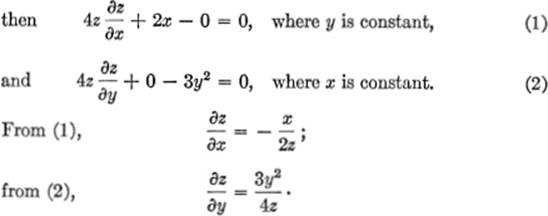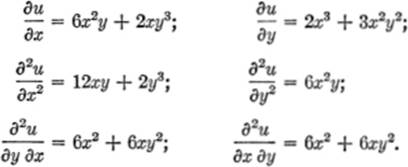The Calculus Primer (2011)
Part X. Partial Differentiation
Chapter 35. PARTIAL DERIVATIVES
10—1.Functions of Several Variables. Thus far we have been dealing with functions such as:
(1)f(x) = y = x3 + 2x2 − 5x + 6
(2)y = x log x
(3)y2 = 2px
(4)x2 + y2 = r2
In these illustrations, (1) and (2) are explicit functions, while (3) and (4) are implicit functions. In all four instances, however, only two variables appear, either of which may be expressed as a function of the other; that is, each equation may be written either as y = f(x), or as x = F(y). These are functions involving only one independent variable.
Frequently, however, three or more variables may be related, as in the following examples:
(5)z2 = x2 + y2
(6)E = IR
(7)V = ![]() πr2h
πr2h
(8)PV = kT, or P = kT/V
(9)I = P(l + i)n
(10)H = .24I2Rt
Here (5), (6), (7), and (8) are each functions involving two independent variables; (9) and (10) are functions of three independent variables. When a quantity is a function of more than one variable, it is possible to “hold” one of the variables constant and investigate how the other variables are related to each other, and to the function. For example, in (7), if the altitude h of a cone remains constant, then doubling the value of r makes V four times as great; by holding r constant, and doubling h, the value of V becomes twice as great; doubling both r and h makes V eight times as great; etc. The various relations between the rates of change of variables with respect to one another, and of the function as a whole, are conveniently studied by means of partial derivatives.
A function whose value depends upon two variables is written as F (x,y). For example:
(1)if z2 = x2 + y2, then z = F(x,y) = ± ![]()
(2)if PV = kT, then V = F(P,T) = kTP−1.
Similarly, if a quantity depends upon three variables, the functional relation is expressed as
u = F(x,y,z).
10—2.Definition of a Partial Derivative. Consider z as a function of two independent variables x and y, that is,
z = f(x,y).
Then the derivative of z with respect to x as x varies, but y remains constant, is called the partial derivative of z with respect to x; it is denoted by ![]() . In like manner, if we hold x constant and allow y to vary, the partial derivative of zwith respect to y is denoted by
. In like manner, if we hold x constant and allow y to vary, the partial derivative of zwith respect to y is denoted by ![]() . For example:
. For example:
ifz = ax2 + 3xy + y2,
![]() = 2ax + 3y, since y is here regarded as a constant,
= 2ax + 3y, since y is here regarded as a constant,
![]() = 3x + 2y, since x is here regarded as a constant.
= 3x + 2y, since x is here regarded as a constant.
This notion of a partial derivative can be applied to implicit functions as well as to an explicit function as in the above illustration.
Thus, if2z2 + x2 − y3 = 8,

The concept and notation of partial derivatives may also be extended to functions of more than two independent variables.
EXAMPLE 1.Find the partial derivatives of u, given
u = xy + xz − yz.
Solution.
![]() = y + z, where y and z are constants;
= y + z, where y and z are constants;
![]() = x − z, where x and z are constants;
= x − z, where x and z are constants;
![]() = x − z, where x and y are constants.
= x − z, where x and y are constants.
EXAMPLE 2.If x3 − y3 + z3 = 3xyz, find ![]() and
and ![]() .
.
Solution.
Differentiating “implicitly” with respect to x:

Differentiating with respect to y:
![]()
![]()
EXERCISE 10—1
In each of the following, find all the partial derivatives of z or u:
1. z = x3 + 5x2y + y3
2. z = ex log y
3. u = Ax2 + Bxy + Cy2 + F
4. z = eax+y
5. u = sin ![]()
6. u = xy
![]()
8. z = y log x
9. x2 + y2 − z2 = 36
10. x2y2 + y2z2 + x2z2 = 2a

10—3.Higher Partial Derivatives. Inasmuch as the first partial derivatives of a function of several independent variables are also functions of those variables, the partial derivatives of these first partial derivatives may also be found; the results are known as second-order partial derivatives.
Thus, if u = f(x,y), then, by partial differentiation, we obtain two first-order partial derivatives, ![]() and
and ![]() , and four second-order partial derivatives, as follows:
, and four second-order partial derivatives, as follows:

It can be shown that if the “cross-derivatives” ![]() and
and ![]() are continuous, they are identical; that is, the order of differentiation does not affect the result.
are continuous, they are identical; that is, the order of differentiation does not affect the result.
In a similar manner, partial differentiation of the four second-order derivatives yields eight third-order partial derivatives.
EXAMPLE. Find the second-order partial derivatives of
u = 2x3y + x2y3.
Solution.

EXERCISE 10—2
Find all the second-order partial derivatives:
1. u = ![]() (x3 + y3 + 3xy)
(x3 + y3 + 3xy)
2. z = sin xy
3. u = ex + ey
4. z = exy
5. x3y2 + 3xy3 = z
6. z = x3 + 4x2y − y3
In each of the following, verify that ![]()
7. u = sin (x + y)
8. u = y log xy
9. ![]()
10. u = x cos y
In each of the following, verify the relation given:
11. If z = log (x2 + y2), prove that
![]()
12. If u = x3 + y3, prove that
![]()